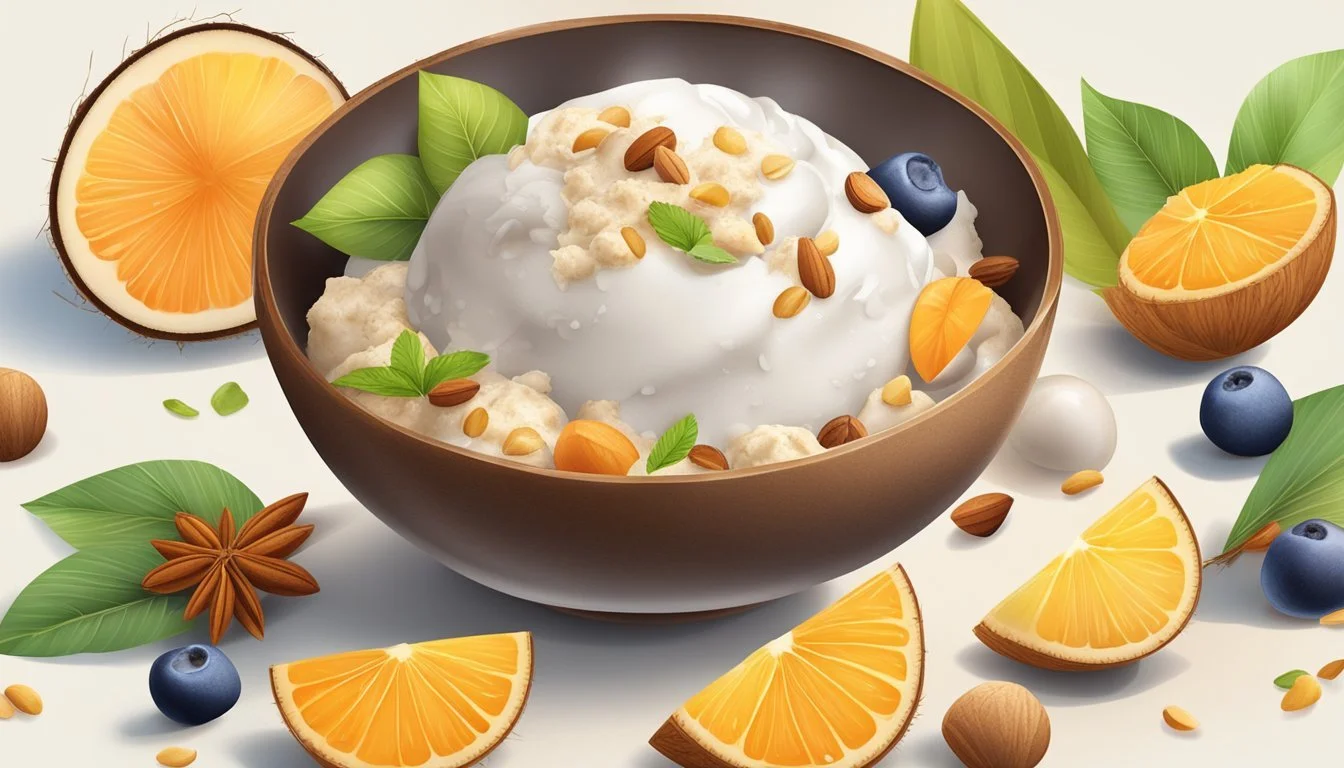8 Healthy Desserts for People with Diabetes
Delicious and Diabetes-Friendly Recipes
Finding desserts that are both delicious and suitable for those managing diabetes can be a challenge. This article offers eight mouth-watering options that help you maintain a balanced diet without compromising on flavor or enjoyment.
Each dessert is crafted to be diabetes-friendly, ensuring they are low in sugar and packed with beneficial nutrients. These recipes aim to provide healthier alternatives that cater to the dietary needs of people with diabetes, making it easier to indulge responsibly.
1) Greek Yogurt with Berries
Greek yogurt with berries is a nutritious and delicious dessert option for people with diabetes. This combination offers a balanced mix of protein, fiber, and antioxidants.
Start by selecting plain Greek yogurt, which is lower in sugar than its flavored counterparts. Greek yogurt provides a good source of protein, helping to regulate blood sugar levels.
Fresh berries like strawberries, blueberries, and raspberries are excellent choices. They are low in sugar and high in fiber, making them ideal for managing diabetes.
To assemble this dessert, layer the Greek yogurt in a bowl or glass. Add a generous handful of mixed berries on top.
For an extra touch of flavor, consider adding a sprinkle of cinnamon or nutmeg. This can enhance the sweetness without adding sugar.
Optional ingredients include a small amount of chopped nuts or a drizzle of honey. However, it's important to keep any added sweeteners to a minimum.
This simple and elegant dessert is both satisfying and diabetes-friendly. It's a perfect way to enjoy a sweet treat while maintaining healthy blood sugar levels.
2) Chia Seed Pudding
Chia seed pudding is a versatile and nutritious dessert perfect for those managing diabetes. The main ingredients typically include chia seeds and a liquid base like almond or coconut milk. These seeds are rich in fiber, protein, and omega-3 fatty acids, which help stabilize blood sugar levels.
Preparing chia seed pudding is simple. Combine chia seeds with your chosen liquid, stir well, and let it sit in the refrigerator for a few hours or overnight. This allows the mixture to thicken into a pudding-like consistency.
Chia seed pudding can be customized with various flavorings and toppings. Some popular options include adding unsweetened cocoa powder for a chocolatey twist, or fresh fruits like berries and kiwi for added texture and flavor. Natural sweeteners like Stevia or a small amount of honey can also be used.
Not only is chia seed pudding healthy, but it is also easy to make and can be prepared in advance. This makes it a convenient dessert option for those with busy schedules.
3) Apple Slices with Peanut Butter
Apple slices with peanut butter offer a delicious and diabetes-friendly snack that combines both flavor and nutrition. The fiber in apples helps manage blood sugar levels, while the protein in peanut butter provides staying power, making this a balanced option.
For simplicity, wash and core an apple, then slice it into wedges. Spread a thin layer of natural, unsweetened peanut butter on each slice. This combination gives a satisfying crunch with a creamy finish.
Natural peanut butter is recommended as it contains no added sugars. This ensures that the snack remains low in sugar and high in beneficial nutrients. Choose apples like Granny Smith or Fuji for their crisp texture and mildly sweet flavor.
This snack is quick to prepare and portable, making it a convenient choice for busy individuals. It's perfect for an afternoon energy boost or a nutritious dessert alternative.
4) Cottage Cheese and Pineapple
Cottage cheese and pineapple create a delightful pairing that balances taste and health. Both ingredients bring their unique benefits to the table, making this combination suitable for individuals with diabetes.
Cottage cheese is a low-fat, protein-rich dairy product. It helps maintain stable blood sugar levels by providing a consistent source of energy. Its low glycemic index makes it a favorable option for diabetic-friendly recipes.
Pineapple adds a natural sweetness and a dose of essential vitamins. Though it contains natural sugars, in controlled portions, it offers vitamin C and fiber. These nutrients can support overall health without causing significant spikes in blood sugar.
When preparing this dessert, it's important to monitor portion sizes. Combining a measured serving of low-fat cottage cheese with a small portion of pineapple can create a satisfying, diabetes-friendly treat.
For added flavor, some might consider sprinkling a bit of cinnamon or a few nuts on top. These additional elements can enhance taste without compromising dietary goals.
5) Dark Chocolate Avocado Mousse
Dark Chocolate Avocado Mousse
6) Almond Flour Brownies
Almond flour brownies provide a rich and satisfying dessert option for people with diabetes. Made using nutrient-dense almond flour, these brownies offer a lower carbohydrate content compared to traditional flour-based brownies. This makes them a better choice for blood sugar management.
The ingredients typically include cocoa powder, baking powder, salt, eggs, coconut sugar, and vanilla. Almond flour's high protein and fiber content can help stabilize blood sugar levels. Incorporating healthier sweeteners like coconut sugar or a sugar substitute can further reduce the glycemic impact.
To prepare, mix the dry ingredients in one bowl and the wet ingredients in another. Combining these ingredients and folding in melted chocolate and butter creates a smooth, uniform batter. Baking at the right temperature ensures a moist, chewy texture.
Almond flour brownies can be enjoyed as a delicious and diabetes-friendly treat. By focusing on quality ingredients, individuals can indulge without compromising their health goals.
7) Coconut Milk Ice Cream
Coconut milk ice cream is a delightful option for those managing diabetes. Unlike traditional ice cream, it leverages the natural sweetness and creaminess of coconut milk. This makes it both dairy-free and lower in carbohydrates.
Coconut milk contains healthy fats, which can help to stabilize blood sugar levels. This characteristic can be particularly beneficial for people with diabetes. Additionally, it's often lighter on the stomach than dairy-based alternatives.
When selecting coconut milk ice cream, it's important to check the ingredient list. Some brands add excessive sugars or artificial sweeteners. Opt for those that use natural sweeteners like stevia or monk fruit.
Homemade versions provide greater control over ingredients. Simple recipes might include coconut milk, a natural sweetener, and a flavoring like vanilla or fruit. This can be a healthier choice that allows customization according to dietary needs.
Varieties of coconut milk ice cream can also feature additional nutritious ingredients. For instance, berries can add antioxidants, and nuts can offer a dose of protein and additional healthy fats.
Portion control is also key. Even healthy desserts can impact blood glucose if consumed in large quantities. A small serving can provide satisfaction without the sugar spikes.
Coconut milk ice cream presents a versatile and enjoyable option. It offers both taste and nutritional benefits, fitting seamlessly into a diabetes-friendly diet.
8) Baked Apples with Cinnamon
Baked Apples with Cinnamon make for a delightful and diabetes-friendly dessert.
To prepare this dish, preheat the oven to 425°F (218°C). Core the apples and drizzle them with lemon juice to prevent browning.
In a bowl, mix oats, nuts, a bit of honey or a sugar substitute, and cinnamon. Stuff this mixture into the apples.
Place the apples in a baking dish and add a splash of water or apple cider to the bottom. Cover the dish with foil.
Bake for about 25-30 minutes until the apples are tender. Baste the apples with the liquid from the bottom of the dish every 10 minutes.
Remove the foil toward the end to let the apples brown slightly. Serve warm. This simple dish combines the softness of baked apples with the warm spice of cinnamon, creating a comforting dessert.
Understanding Diabetes and Diet
A balanced diet is crucial for managing diabetes effectively. Key aspects include monitoring sugar intake and managing carbohydrates properly to maintain stable blood glucose levels.
The Role of Sugar in Blood Glucose Levels
Sugar directly impacts blood glucose levels. When consumed, sugars are broken down into glucose and enter the bloodstream. For individuals with diabetes, this process can lead to spikes in blood sugar. This spike occurs because the body either doesn't produce enough insulin or cannot use it effectively.
To mitigate these effects, it is essential to limit the intake of added sugars. Foods and beverages high in simple sugars, such as sodas, candies, and desserts, can cause rapid increases in blood glucose. Instead, people with diabetes should opt for natural sugars found in fruits and vegetables, which are absorbed more slowly and come with additional nutrients.
Managing Carbohydrate Intake
Carbohydrates have a significant impact on blood sugar levels. They are broken down into glucose, which raises blood sugar. Managing carbohydrate intake is, therefore, a key strategy in diabetes management.
One effective approach is carbohydrate counting, which involves tracking the number of carbs consumed. This helps in planning meals that keep blood glucose levels stable. Focusing on complex carbs, such as whole grains, legumes, and vegetables, can be beneficial as they digest slowly and do not cause rapid blood sugar spikes. Additionally, including fiber-rich foods can help improve glucose control.
By understanding and managing the roles of sugar and carbohydrates, individuals can better control their diabetes and enjoy a more varied diet.
Nutritional Benefits of Healthy Desserts
Healthy desserts for people with diabetes provide essential nutrients that can help manage blood sugar levels. They often incorporate ingredients with a low glycemic index and high fiber content, contributing to better overall health and glucose control.
Low Glycemic Index Ingredients
Healthy desserts utilize ingredients with a low glycemic index (GI), helping to prevent spikes in blood sugar levels. Low-GI foods release glucose into the bloodstream slowly, providing stable energy levels. Examples include whole grains, nuts, and berries. Whole grains like oats and quinoa contain complex carbohydrates that take longer to digest and absorb, ensuring a steady flow of energy.
Including nuts such as almonds and walnuts in desserts adds both protein and healthy fats, which further moderates the release of glucose. Berries, while sweet, have a low GI and are rich in antioxidants and vitamins. These ingredients not only support glucose management but also contribute to heart health.
High Fiber Options
Fiber-rich desserts are particularly beneficial for individuals with diabetes. Fiber slows down the absorption of sugar into the bloodstream, helping to maintain steady blood sugar levels. Foods high in fiber, such as fruits, vegetables, and whole grains, are often incorporated into healthy dessert recipes.
For instance, a dessert made with whole grains, such as an oat-based treat, can offer significant amounts of dietary fiber. Similarly, desserts that include fruits like apples, pears, or berries provide both soluble and insoluble fiber, aiding in digestion and glucose regulation. Additionally, the inclusion of plant-based ingredients like chia seeds or flaxseeds not only increases fiber content but also provides omega-3 fatty acids, further supporting metabolic health.
Tips for Preparing Diabetes-Friendly Desserts
Creating desserts that are suitable for people with diabetes involves choosing the right alternatives to traditional high-sugar ingredients and incorporating nutrient-rich fruits and vegetables.
Sweetener Alternatives
When preparing desserts, it's crucial to use sweeteners that won't spike blood sugar. Stevia, derived from the leaves of the Stevia plant, is a popular choice as it doesn't affect blood glucose levels. Another good option is erythritol, a sugar alcohol that adds sweetness without raising insulin levels.
Honey and maple syrup offer natural sweetness but should be used sparingly. For baking, consider using monk fruit sweetener, which has zero calories and carbohydrates. Agave nectar is another alternative, though it should be used carefully due to its high fructose content.
Always avoid artificial sweeteners that may cause digestive issues or have questionable impacts on health. Experimenting with these sweeteners will help identify which one suits your taste preferences and dietary needs best.
Incorporating Fruits and Vegetables
Deserts often benefit from the natural sweetness and nutritional benefits of fruits and vegetables. Fruits such as berries, apples, and pears provide fiber and vitamins, which help in stabilizing blood sugar. Alternatively, use bananas and dates sparingly due to their higher sugar content.
Vegetables like zucchini and sweet potatoes can add moisture and nutrients to desserts. For example, sweet potatoes can be used in brownies and muffins, while zucchini works well in cakes and breads.
Adding mashed avocado to chocolate mousse or brownies not only enriches the flavor but also provides healthy fats. Utilizing these ingredients enhances the nutritional profile while keeping sugars in check.








